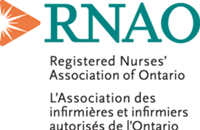New nursing guideline takes aim at growing substance-use rates
TORONTO, March 31, 2015 /CNW/ - One in four Canadians is living with a substance-use disorder. And, if statistics are any indication, many likely won't get the help they need.
According to the Canadian Centre on Substance Abuse, only 0.4 per cent of Canadians using drugs or alcohol are also using publicly funded substance-use treatment services, pointing to a need for greater government leadership when it comes to identification and treatment services.
A new guideline compiled by Ontario's top professional nursing association takes aim at this troubling trend by recommending nurses in every health-care setting ask their clients if they use drugs, such as cannabis and opioids, or consume alcohol. The Supporting Clients Who Use Substances Best Practice Guideline (BPG) was released today by the Registered Nurses' Association of Ontario (RNAO). Its goal is to provide nurses with recommendations to both assess and treat clients, regardless of setting or geographic location.
The document was crafted by an expert panel of registered nurses, nurse practitioners and other health-care leaders from across Ontario, including co-lead Wayne Skinner, deputy clinical director in ambulatory care and structured treatment, and head of the Problem Gambling Institute of Ontario at Toronto's Centre for Addiction and Mental Health. "This BPG is an invaluable tool for nurses and all health providers because it will help them, in conjunction with the client, to chart a safe, effective and appropriate path to improved wellbeing and recovery," he says.
The BPG outlines many tools health providers can turn to, including a questionnaire from Health Canada that lists three yes/no questions to be used when screening all clients for substance use on initial contact:
- Have you ever had any problems related to your use of alcohol or other drugs?
- Has a relative, friend, doctor or other health-care provider been concerned about your drinking or other drug use, or suggested cutting down?
- Have you ever said to another person, "No, I don't have an alcohol or drug problem" when, around the same time, you questioned yourself and felt, "Maybe I do have a problem?"
Once a client discloses, nurses are encouraged to advocate for them and support access to appropriate interventions, such as counselling and medication.
The BPG also contains 14 recommendations tailored to all sectors. One, in particular, targets youth and adolescents who are experiencing substance-use disorder or are at risk. People between the ages of 15 and 24 are three times more likely to have a substance-use disorder than those over the age of 24. The BPG, which is targeted to people 11 and older, encourages providers to partner with youth, adolescents and family members throughout recovery.
Other distressing statistics indicate soaring prescription opioid use in Canada. "It's time to talk about substance use. We must ensure all nurses and other health providers are given the necessary skills and tools, including this RNAO guideline, to engage with clients who use substances and are at risk, or are experiencing substance-use disorder," says Sabrina Merali, RNAO program manager. The guideline, Merali adds, will also help health professionals feel comfortable discussing substance-use disorders. "Talking about it, in every health-care setting, will go a long way towards helping to reduce stigma linked to substance-use disorder."
Among the other BPG recommendations:
- Provide continuing education for health providers to enhance their ability to assess and work with clients at risk or experiencing a substance-use disorder.
- Integrate components of harm reduction and the social determinants of health into organizations addressing substance use disorders.
- Ensure undergrad nurses and other health providers are equipped with theory and clinical practice opportunities.
To download the full guideline, visit RNAO.ca/substanceuse
RNAO's Best Practice Guidelines Program is funded by the Ministry of Health and Long-Term Care, and was launched in 1999 to provide the best available evidence for patient care across a wide range of health-care settings. The 51 guidelines developed to date are a substantial contribution towards building excellence in Ontario's health system. They are available to all health professionals in Canada and abroad. To learn more about RNAO's Nursing Best Practice Guidelines Program or to view these resources, please visit
This year marks the Registered Nurses' Association of Ontario's (RNAO) 90th anniversary. RNAO is the professional association representing registered nurses, nurse practitioners, and nursing students in Ontario. Since 1925, RNAO has advocated for healthy public policy, promoted excellence in nursing practice, increased nurses' contribution to shaping the health-care system, and influenced decisions that affect nurses and the public they serve. For more information about RNAO, visit our website at RNAO.ca or follow us on Facebook and Twitter.
SOURCE Registered Nurses' Association of Ontario

about this guideline, please contact: Marion Zych, Director of Communications, RNAO, Cell: 647-406-5605, Phone: 416-408-5605, [email protected]

Share this article